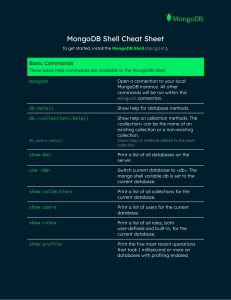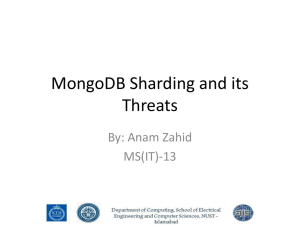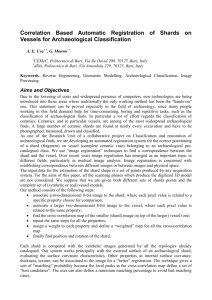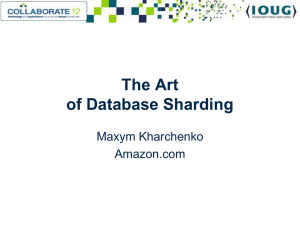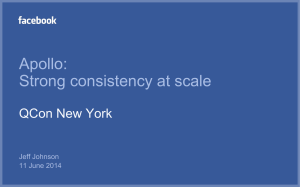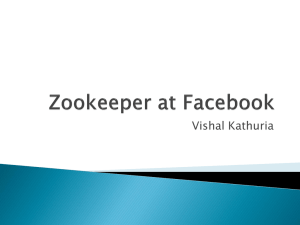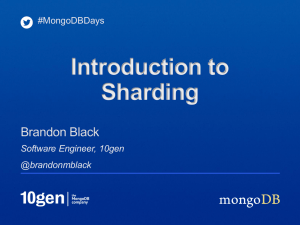MongoDB Sharding 101: Scaling Databases
advertisement
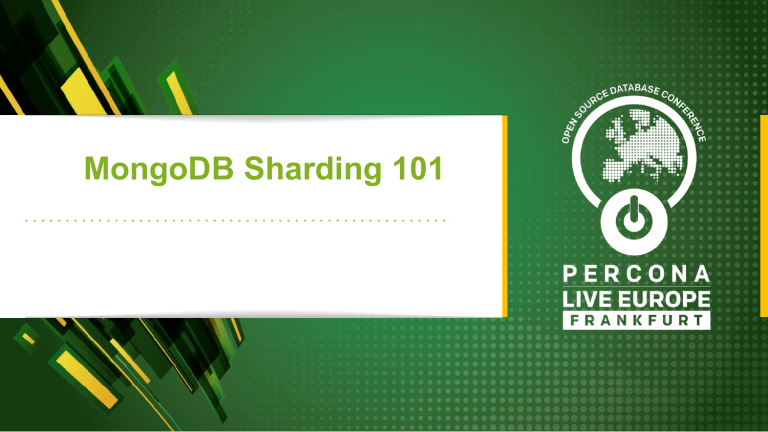
MongoDB Sharding 101 Agenda ● ● ● ● ● What is MongoDB? Single Instances Replica-set architecture Shard architecture Q&A What is MongoDB MongoDB MongoDB is a free and open-source, cross-platform, document-oriented database program. Classified as a NoSQL database program, MongoDB uses JSON-like documents with schemata. MongoDB is developed by MongoDB Inc., MongoDB ● ● ● ● Open source document-oriented database Made to run in the cloud, easily scalable Quick installation and configuration Fast deployment, schema-free Single Instances Single Instance Single Instance ● Commonly used for development/tests ● Embedded systems Single Instance MongoDB mobile is currently in Beta IoT, Android, TV, IOS Replica-sets Replica-set ● ● ● ● Way to scale out Ability to elect a new primary in case of failure (auto HA) Data are the same in the replicas, asynchronous replication. Single master - PRIMARY Replica-set How does a replica-set work? Main collection when running PRIMARY replica-set is oplog.rs; Secondary Secondary Replica-set - oplogs How does a replica-set work? Secondaries Pull oplog and apply locally Replica-set Replica-set ● ● ● ● ● Heartbeat Votes Priority Arbiter Hidden Replica-set How does a replica-set work? Chained replication Secondaries Pull oplog and apply locally Replica-set How does a replica-set work? Delayed Secondary Secondaries Pull oplog and apply locally Replica-set What if a heartbeat fails? An election process will promote a secondary to primary when the primary is no longer available. The most up to date instance has preference to become a primary, although it is not always true. Replica-set What if a heartbeat fails? Each instance can have different priorities, in sum the higher the priority, the greater the probability of the instance becoming a primary. Arbiters do not hold data, they're only used to break ties in elections. Use an arbiter if a replica set has an even number of members. Replica-set ● Tweaking the consistency - readPreference writeConcern Replica-set - writeConcern The default write concern value is "1", which means that once the primary receives the operation, it is considered complete. If an election is triggered, we can lose this operation as it might not be replicated. It is possible to specify a different writeConcern per query or per connection. The possible values are: 1, 2, 3, N / "majority" / "tag_name" Replica-set - readPreference Read Preference is primary. Every single read will come from the primary if we don't specify a parameter for the driver to read from secondaries. Important! Reading from secondaries may return outdated, stall data.. However, this is a very common way to scale out read intensive applications. Cluster (Shards) Sharded Cluster Config Servers mongos Shard1 Shard2 Sharded Cluster architecture Mongos Config Shards Sharded Cluster - chunks shard1 A database can have multiple collections, each collection can be sharded differently. Each shard has chunks and their documents. shard2 Sharded Cluster Primary Shard Data are split among shards in small chunks by the shard key. Each chunk has 64MB data (default). Chunks are distributed among the shards but can also live in a single one. Sharded Cluster - Shard key Shard key: Field(s) that will be used to distribute the data among the shards. Once data is partitioned there is no way to change the shard key. (No other key except _id/not part of shard key columns could be unique - you can explain about this) A shard key can be used to distribute data in: ● Hashed ● Range ● Zones Sharded Cluster Hashed Shard key: Sharded Cluster Range Shard key: Sharded Cluster TAG Shard key: Sharded Cluster Clustered shard parts: The config servers - All cluster metadata is there Partitions, collections, databases configuration Migrations Sharded Cluster Clustered shard parts: The mongos - Responsible for routing all the queries Act like a proxy Merge results to send to the client Clients think it is a single instance Sharded Cluster Clustered shard parts: The shard - It is a replica-set after all. Members of a shard do have the same data. Only part of the data is saved on a shard. Sharded Cluster Config Servers mongos Shard1 Shard2 Sharded Cluster - Internals Clustered shard parts, configuration and processes ● ● ● ● ● Balancer Chunk Migration Orphan documents Auto split Jumbo chunk Sharded Cluster - Internals Clustered shard processes: Balancer Balancer is the process responsible for moving chunks along instances. We highly suggest keeping balancer on to distribute the data. This process directly changes data in the config database. ● Schedule “balancer window” ● Chunk size Sharded Cluster - Internals Clustered shard processes: Chunk Migration In case there are too many chunks in a specific shard, the balancer will move those data to different shards. Each migration will migrate an entire chunk (64mb) to a different shard. If the migration fails we may end up with data in a shard that do not belong to the shard range. Such documents are called orphan documents. Sharded Cluster - Internals Clustered shard processes: Split It is possible to split a chunk manually or wait until the balancer figures out whether there is a chunk to be split or not. The auto split process will divide this chunk in two and might migrate part of the old chunk to another shard. Sharded Cluster - Internals Clustered shard processes: Jumbo Chunk Sometimes it is not possible to split a chunk and we see a chunk with the "jumbo:true". This means this chunk is bigger than 64MB and it is not possible to split it automatically, mainly because the shard key doesn't have enough selectivity. Sharded Cluster - Queries Querying into a shard - - Mongos is the process that in fact "talks" to the shards. All the queries go through the MongoS process before returning results to the client. Target query, scatter gather, collection scans. Sharded Cluster - Queries - If querying by the shard key, it is very likely that the mongos "knows" where to retrieve data. Sharded Cluster - Queries - If querying by something different than the shard key, all the shards will be requested to fetch data and mongos will combine the results to the client, returning one single result. Wrapping up ● Applications don't know they are talking to a shard. Mongos acts as if it were a proxy. ● Shards are basically a few replica-sets sharing data among them. ● The config database is really, really important. Do not... ● ● ● ● Write directly into the Shard; Make changes in config database, unless you really know what you are doing. Run a collection scan in Shard. Backup separately without consistency state Questions?
